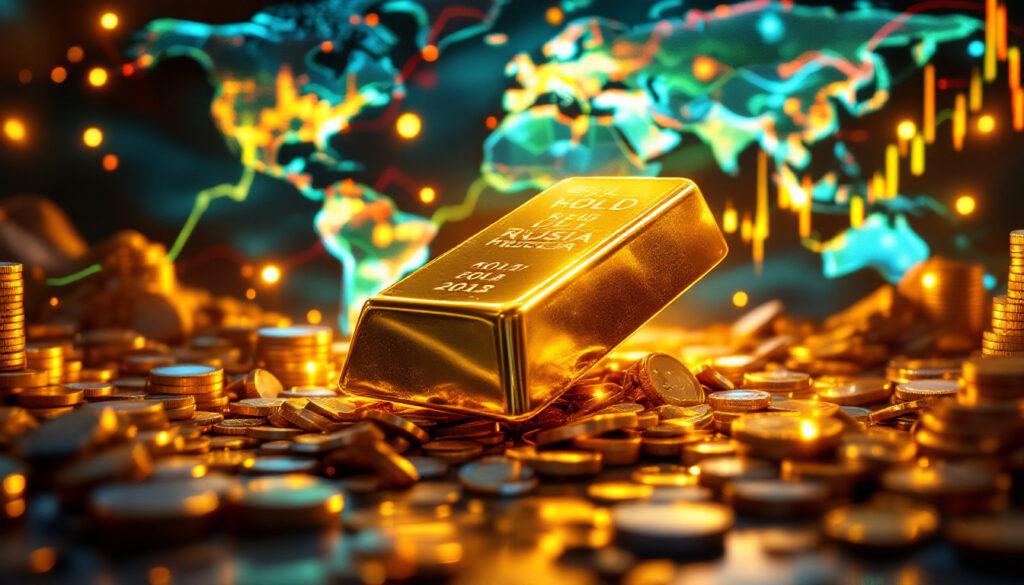Understanding Gold's Current Market Position
The Recent Gold Bull Market
Gold has experienced a remarkable bull run in recent times, rising from $2,000 to $3,200 per ounce – representing approximately a 30% increase year-to-date. This impressive price movement has firmly established gold as one of the best-performing asset classes of 2024, outpacing many traditional equity and fixed-income investments.
Recent tariff announcements have acted as a significant catalyst for gold's price surge, with the precious metal demonstrating its unique ability to anticipate market shifts. Gold typically rallies ahead of major economic changes, functioning as an early warning system for structural shifts in the global financial landscape. This predictive quality has been on full display as gold began its ascent before many investors recognized the implications of changing trade policies.
According to market analysts, this bull market differs fundamentally from previous cycles. Unlike the speculative frenzy that characterized the 2011-2012 gold peak, the current rally has been driven primarily by institutional buying, particularly from central banks, rather than retail investor exuberance. This institutional foundation suggests the potential for a more sustainable long-term trend.
Gold's Role in a Changing Global Financial System
The global financial architecture appears to be undergoing a significant transformation, with gold positioned as a key beneficiary. Recent tariff policies signal a potential shift away from the US dollar's dominance as the world's reserve currency – a structural change that market experts believe could play out over years, not months.
As nations seek alternatives to dollar-denominated assets, gold stands out as one of the few viable options for large capital flows. Its 5,000-year history as a monetary metal, combined with its lack of counterparty risk, makes gold uniquely positioned in this transitional period. While cryptocurrencies like Bitcoin have gained attention as potential "digital gold," they lack the established track record and institutional acceptance that physical gold enjoys.
Central bank buying has been perhaps the most significant driver of gold's recent price movement. Central banks globally purchased 1,037 tonnes of gold in 2023, marking the second highest year on record. This trend has continued into 2024, with Q1 purchases on pace to exceed previous years. Notably, emerging market central banks like those in China, India, and Turkey have been particularly aggressive buyers, recognizing gold's utility in diversifying reserves away from Western currencies.
Why Gold Remains an Attractive Investment
The Contrarian Case for Gold Despite Recent Gains
Despite gold's substantial price appreciation, several contrarian indicators suggest this bull market may still be in its early stages. Gold mining ETFs like GDX have experienced substantial outflows (15-20% of shares outstanding) even as gold prices have risen significantly. This unusual divergence between price action and capital flows indicates the market is not yet overheated, as capital inflows typically surge at market tops.
IPO activity in the mining sector provides another compelling data point. The year 2024 is reportedly tracking as the worst year for mining stocks guide on the Australian Securities Exchange (ASX) in recent history. This lack of new issuance stands in stark contrast to the flurry of mining IPOs that typically characterize late-stage bull markets, suggesting considerable room for expansion before reaching excessive optimism.
Furthermore, the absence of mainstream financial media coverage of gold investments relative to technology stocks or cryptocurrencies signals that retail investor participation remains muted. The current environment lacks the speculative frenzy characteristic of late-stage bull markets, where taxi drivers and hairdressers offer tips on gold stocks performance – a classic sign of market tops that remains notably absent.
Gold's Underrepresentation in Investment Portfolios
In the United States and many Western economies, gold remains a fringe asset with minimal allocation in typical investment portfolios. Average gold exposure in US portfolios is estimated to be less than 0.5%, significantly below historical allocations during periods of currency debasement or inflation.
Gold mining exposure represents less than 0.3% of total ETF assets under management – a stark underweighting compared to the sector's potential importance in a diversified portfolio. For context, at the 2012 peak, gold mining exposure was nearly 1.5% of total ETF AUM, suggesting significant room for growth before reaching previous allocation highs.
This underrepresentation creates a compelling opportunity for contrarian investors. If institutional portfolio managers begin increasing their gold allocations even modestly – from 0.5% to 2% for example – the impact on gold prices could be substantial given the relatively small size of the gold market compared to global equities or bond markets.
Diversifying Within the Precious Metals Space
Is Silver the Next Opportunity?
While gold has captured headlines with its dramatic price movements, silver presents potentially greater upside for investors willing to tolerate higher volatility. Silver has not experienced the same percentage price appreciation as gold, creating a historically wide gold-to-silver ratio that many analysts view as unsustainable.
The fundamentals for silver appear particularly compelling. The market is facing its fifth consecutive year of supply deficits, with industrial demand continuing to grow while mine supply remains constrained. Silver's dual role as both a precious metal (monetary store of value) and an industrial commodity (essential for electronics, solar panels, and medical applications) provides unique exposure to both financial market sentiment and technological growth.
A distinctive characteristic of silver markets is their tendency to move quickly and substantially when momentum shifts. Silver's smaller market size relative to gold means that when investment demand increases, price movements can be explosive. The challenge for investors lies in finding quality mining equities in the silver space, as the universe of well-managed, financially sound silver producers is more limited than in the gold sector.
The Long-Awaited Platinum Opportunity
Platinum represents perhaps the most extreme contrarian opportunity within the precious metals complex. The metal has been in a prolonged downturn since peaking in 2008, with prices depressed despite consistently strong fundamentals. This disconnect between price and fundamentals creates a compelling entry point for patient investors.
Supply constraints in platinum are particularly acute. There has been limited new investment in production capacity, with major miners focusing on maintenance rather than expansion. The global platinum market faces structural supply limitations, with approximately 80% of global production concentrated in South Africa – a jurisdiction facing persistent electricity shortages, labor issues, and political uncertainties.
The next largest producers – Zimbabwe and Russia – face significant geopolitical and investment challenges that make substantial production increases unlikely. Meanwhile, demand dynamics are shifting favorably with hybrid vehicles, which use more platinum group metals than traditional combustion engines, seeing strong growth even as pure electric vehicle adoption slows in some markets.
Geopolitical Factors Affecting Precious Metals
How Political Changes Impact Mining Jurisdictions
The mining sector is inherently sensitive to political developments, with regulatory frameworks and taxation regimes varying dramatically across jurisdictions. Recent shifts toward more business-friendly administrations in Latin America could create significant investment opportunities that were previously inaccessible due to political risk.
Argentina under President Milei represents a dramatic example of this transition, with the new administration actively courting mining investment after years of sector-unfriendly policies. Similar potential changes are emerging in Colombia and Ecuador, where resource nationalism may be giving way to more pragmatic economic policies that recognize the importance of resource development for economic growth.
The United States has demonstrated increased interest in securing critical minerals supply chains in Latin America, viewing the region as a natural partner for reducing dependency on Chinese and Russian sources. This geopolitical realignment is creating opportunities for North American miners with projects in Latin America to access both capital and favorable trade terms.
Conversely, Indonesia's recent regulatory changes have created significant challenges for nickel producers, with proposed royalty increases from 9% to 14-19% threatening project economics. This illustrates how quickly regulatory environments can shift, reinforcing the value of political diversification within mining portfolios.
Supply Constraints and Security Concerns
South Africa's platinum industry faces ongoing challenges despite moderate improvements in the operating environment. Persistent electricity shortages from utility provider Eskom continue to limit production capacity, while labor disputes and safety concerns compound operational difficulties. These challenges, combined with limited capital investment in new projects, suggest platinum supply will remain constrained for the foreseeable future.
Indonesia's growing environmental concerns regarding nickel mining methods, particularly the disposal of tailings in oceanic environments, represent another potential supply disruption. As the world's largest nickel producer, any regulatory tightening in Indonesia could have significant implications for global supply balances.
The Biden administration has been actively working to create trading blocks for critical materials and commodities, recognizing that mineral security is increasingly intertwined with national security. This policy direction favors miners operating in friendly jurisdictions like Canada, Australia, and potentially select Latin American countries where rule of law and environmental standards align with Western expectations.
Alternative Metals and Investment Opportunities
The Contrarian Case for Vanadium
Vanadium presents one of the most compelling contrarian investment opportunities within the metals complex. Vanadium pentoxide prices have collapsed approximately 80-85% from their 2018 peak of $30/lb to around $5/lb – a price level at which much of the primary production cost curve is underwater. This pricing environment is unsustainable over the medium term, creating potential for significant price recovery.
Approximately 70% of global vanadium production comes as a co-product of steel making, with China and Russia dominating production. This concentration creates significant security of supply concerns for Western economies, particularly as vanadium is critical for high-strength steels used in infrastructure and defense applications.
The potential demand growth from vanadium redox flow batteries represents a compelling wild card. These energy storage systems, while currently niche, offer advantages over lithium-ion batteries for certain grid-scale applications, particularly where duration of storage is prioritized over energy density. If adoption accelerates, vanadium demand could increase substantially from a relatively small base.
Nickel Market Dynamics
Indonesia's proposed royalty increases represent a significant threat to producer profitability in the world's largest nickel producing nation. With potential increases from 9% to 14-19%, many Chinese-backed operations in Indonesia are likely struggling at current nickel prices, raising questions about the sustainability of supply.
Environmental concerns about high-pressure acid leach (HPAL) nickel mining methods have created growing pushback within Indonesia, with local communities increasingly vocal about tailings disposal practices. This represents a potential regulatory risk that could further constrain supply if stricter environmental standards are implemented.
Nickel represents one of the most contrarian investment opportunities alongside cobalt and lithium. All three metals have experienced dramatic price collapses despite their critical importance to battery technology and the energy transition. This disconnect between near-term price action and long-term demand fundamentals creates potential opportunities for investors with patience and risk tolerance.
Investment Strategies in the Mining Sector
The Appeal of Royalty Companies
Royalty companies offer investors exposure to commodity price upside without the operational risks inherent in mining operations. These businesses provide upfront capital to miners in exchange for a percentage of future production or revenue, creating a capital-light business model in an otherwise capital-intensive industry.
The financial advantages of this model are compelling. Royalty companies typically boast high returns on equity and capital invested, with profit margins often exceeding 60% compared to 30-40% for even the best-run mining companies. This structural advantage derives from avoiding the ongoing capital expenditures, labor challenges, and operational complexities that traditional miners face.
Major North American precious metals royalty companies have significantly outperformed the NASDAQ from 2012 to present, demonstrating their ability to deliver superior returns through multiple market cycles. This outperformance reflects both their business model advantages and disciplined capital allocation.
Royalty companies trade at premium multiples compared to mining equities, reflecting their lower risk profile and higher quality earnings streams. While this premium valuation may appear expensive on traditional metrics, the quality of earnings and downside protection have historically justified the premium, particularly for investors seeking reduced volatility within their mining exposure.
Management Quality as a Critical Factor
High-quality management represents perhaps the most crucial success factor in mining investment – more important than deposit quality or commodity exposure. The mining sector's history is littered with examples of world-class deposits destroyed by poor management decisions, while mediocre assets have created substantial shareholder value under exceptional leadership.
Industry veterans often remark that an average deposit with an A+ management team will outperform an excellent deposit with poor management. This reflects the thousands of critical decisions made throughout a project's life cycle, from initial exploration to final reclamation.
Capital management skills are particularly important in the mining sector, where project capital intensity, timeline extensions, and commodity price volatility create complex financing challenges. Management teams with the discipline to raise capital during market strength rather than weakness can create substantial shareholder value through reduced dilution and lower debt burdens.
North American Mining Investment Outlook
Improving Regulatory Environment
The current US administration appears to be streamlining the permitting process for critical mineral projects, recognizing the national security implications of mineral dependency. This represents a significant shift from previous regulatory approaches that often made domestic mining development prohibitively complex and time-consuming.
There's a growing bipartisan push for domestic production of critical materials, creating a more supportive policy environment for projects in strategic metals. This policy shift is reflected in initiatives like the Defense Production Act being invoked for battery metals and the Critical Minerals list being expanded and prioritized.
Canada is simultaneously working to reduce regulatory duplication in its permitting system, seeking to maintain strong environmental oversight while eliminating unnecessary delays and uncertainties. The Mining Association of Canada reports that permitting timelines have decreased by approximately 30% for certain project types, though significant challenges remain.
These regulatory improvements have made projects in North America more attractive investment opportunities compared to just 6-12 months ago. While permitting timelines in North America remain longer than in some competing jurisdictions, the combination of improving regulatory efficiency and lower political risk creates a more favorable risk-adjusted outlook.
FAQ: Gold Investment Strategies
What is driving the current gold bull market?
Central bank buying has been a primary driver of gold's recent price appreciation, alongside geopolitical tensions and concerns about the US dollar's reserve currency status. Recent tariff announcements have accelerated this trend by signaling a potential shift in global financial systems. Unlike previous gold bull markets, the current cycle has been characterized by institutional rather than retail buying, suggesting the potential for a more sustainable uptrend. Physical gold holdings by central banks increased by over 1,000 tonnes in 2023, and this pace has continued into 2024, creating consistent demand pressure.
How does gold compare to other precious metals as an investment?
Gold currently offers the most established market with strong central bank support. Silver presents a compelling case with supply deficits and industrial applications but hasn't yet seen the same price appreciation. Platinum remains severely undervalued after a prolonged downturn and could see dramatic price movement when market conditions shift. Each metal has distinct supply-demand fundamentals, with gold having the strongest monetary characteristics, silver offering hybrid monetary-industrial exposure, and platinum primarily driven by industrial demand with limited investment interest currently. Portfolio allocation strategies should consider these different characteristics rather than treating precious metals as a homogeneous asset class.
What percentage of investment portfolios should be allocated to gold?
While there's no one-size-fits-all answer, current allocations in US portfolios average less than 0.5%, which is historically low. Gold can serve as an effective portfolio diversifier, particularly during periods of economic uncertainty and currency debasement. Financial advisors specializing in hard assets often recommend 5-10% allocations to precious metals, with the specific percentage depending on individual risk tolerance, investment timeframe, and gold market outlook. Ray Dalio, founder of Bridgewater Associates, famously stated that "if you don't own gold, you don't know history," and has advocated for gold ETF strategies as a portfolio stabilizer during periods of geopolitical and monetary uncertainty.
How do royalty companies differ from mining companies as investments?
Royalty companies offer exposure to commodity prices without operational mining risks. They typically feature higher margins, better returns on capital, and more consistent performance through market cycles. While they may not offer the same explosive upside as mining equities in a bull market, they provide more reliable long-term returns with lower downside risk. Companies like Franco-Nevada and Wheaton Precious Metals have delivered superior risk-adjusted returns compared to both mining indexes and broader equity markets over multiple cycles. Their business model's capital efficiency allows them to maintain dividend payments even during commodity price downturns, creating more stable income streams than traditional miners.
For investors looking to understand the broader context of gold and investment strategies, comprehensive gold market analysis can provide valuable insights into future trends and opportunities in this asset class.
Looking to Catch the Next Major Mineral Discovery?
Discovery Alert's proprietary Discovery IQ model instantly notifies investors about significant mineral discoveries on the ASX, providing actionable insights before the broader market reacts. Understand why major mineral discoveries can lead to substantial returns by exploring Discovery Alert's dedicated discoveries page.




